Home Tags Posts tagged with "missing jet"
missing jet
Australian government has announced a new search area for the missing Malaysian plane after further analysis of satellite data.
The search will now shift south to focus on an area 1,100 miles off the west coast of Australia, Deputy PM Warren Truss confirmed.
Flight MH370 vanished en route from Kuala Lumpur to Beijing on March 8 with 239 passengers on board.
Officials said they believed the plane had been on autopilot when it crashed.
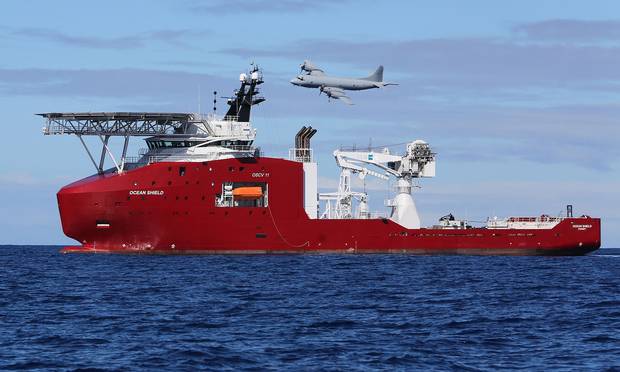
The search for missing MH370 flight will now shift south to focus on an area 1,100 miles off the west coast of Australia
A 64-page report released by the Australian government concluded that the underwater search for the plane should resume in the new area.
An extensive search of the ocean floor was conducted in April after several acoustic pings, initially thought to be from the plane’s flight data recorders, were heard. However, officials now believe the pings were not caused by the plane.
“It is highly, highly likely that the aircraft was on autopilot otherwise it could not have followed the orderly path that has been identified through the satellite sightings,” Warren Truss said.
The underwater search for the plane was put on hold to allow more time for survey vessels to map the ocean floor.
The new search is expected to commence in August and is expected to be completed within a year, Australian Transport Safety Bureau (ATSB) chief Martin Dolan confirmed.
Submarines will scour the ocean floor to look for signs of the missing Boeing 777.
The search for the missing plane is already among most expensive in aviation history.
After more than 100 days since the disappearance of the airliner, many of the relatives of the missing passengers have continued to express frustration at the lack of progress in the search.
[youtube kCKX5LEOq-U 650]
The search for missing Malaysian jet MH370 will move hundreds of miles south, officials have said.
The new phase of hunt will focus on an area 1,100 miles off the city of Perth, Australian Transport Safety Bureau (ATSB) chief Martin Dolan said.
Nearby areas were previously surveyed from the air, but the undersea hunt was directed north after pings were heard.
The jet vanished en route from Kuala Lumpur to Malaysia on March 8 with 239 passengers on board.
Experts had hoped that the pings detected shortly after the plane vanished were from its flight-data recorders.
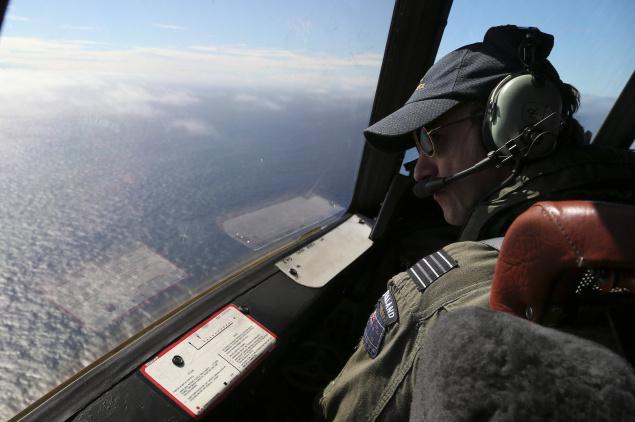
The search for missing Malaysian jet MH370 will move hundreds of miles south
After weeks of searching the ocean floor, it was concluded that the noises were unrelated to the plane.
Search teams have now returned to the initial satellite data to frame the new search area.
“All the trends of this analysis will move the search area south of where it was,” Martin Dolan said.
“Just how much south is something that we’re still working on.”
He said it was unlikely that the new search area would be as far from land as the aerial surveys had been.
Before search teams can start looking for the plane, the seabed will be mapped.
A Dutch firm has been contracted to carry out a detailed survey of the ocean floor.
The sea in the area is 3.8 miles deep, and the analysis is expected to take three months.
Many of the relatives of the missing passengers have been frustrated by the lack of progress in the search.
[youtube xE6yiSQiwrQ 650]
Families of MH370 passengers have begun to receive initial compensation payments of $50,000.
So far six Malaysian families and one Chinese family have received the money, and insurers are assessing the claims of 40 more Chinese families.
Relatives of all 239 missing passengers can claim up to $175,000 each.
Flight MH370 went missing on March 8 as it flew from Kuala Lumpur to Beijing. No trace of the plane has been found.

Families of MH370 passengers have begun to receive initial compensation payments of $50,000 (photo Getty Images)
Malaysian deputy foreign minister Hamzah Zainudin stressed that the government has not yet declared the plane lost.
“When we talk about the full payment, we have to wait until we announce the issue on the tragedy MH370 is over,” he said.
Malaysia Airlines’ insurer, a consortium led by Germany’s Allianz, is making the payments.
Many of the relatives also refuse to accept that their relatives may be dead.
A group of families has joined together to raise $5 million to investigate the plane’s disappearance and encourage anyone who might have information to come forward.
A massive search operation conducted in seas hundreds of miles from any land has failed to find any debris from the plane.
Experts are continuing to survey the sea floor and are bringing in specialist equipment.
They believe the jet ended its journey in the Indian Ocean, hundreds of miles north-west of the Australian city of Perth.
According to the Australian officials, the area where acoustic signals thought linked to the missing Malaysian plane were detected can now be ruled out as the final resting place of flight MH370.
The Bluefin-21 submersible robot had finished its search of the area and found nothing, they said.
Efforts would now focus on reviewing search data, surveying the sea floor and bringing in specialist equipment.
Flight MH370 went missing on March 8 as it flew from Kuala Lumpur to Beijing.
Using satellite data, officials have concluded that the airliner, which had 239 people on board, ended its journey in the Indian Ocean, north-west of the Australian city of Perth.
No trace of the plane has been found and there is no explanation for its disappearance.
Four pings that officials believed could be from the missing plane’s “black box” flight recorders were heard by search teams using a towed pinger locator device.
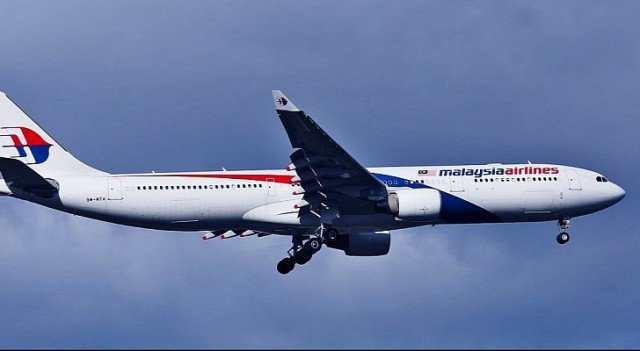
The area where acoustic signals thought linked to the missing Malaysian plane were detected can now be ruled out as the final resting place of flight MH37
These pings were used to define the area for the sea-floor search, conducted by the Bluefin-21. It had scoured over 850 sq km of the ocean floor, JACC said.
“Yesterday afternoon, Bluefin-21 completed its last mission searching the remaining areas in the vicinity of the acoustic signals detected in early April by the towed pinger locator,” a statement from the Joint Agency Co-ordination Centre (JACC) said.
“The data collected on yesterday’s mission has been analyzed. As a result, the JACC can advise that no signs of aircraft debris have been found by the autonomous underwater vehicle since it joined the search effort.
“The Australian Transport Safety Bureau [ATSB] has advised that the search in the vicinity of the acoustic detections can now be considered complete and in its professional judgement, the area can now be discounted as the final resting place of MH370.”
The statement came hours after a US Navy official told CNN that the acoustic signals probably came from some other man-made source.
“Our best theory at this point is that [the pings were] likely some sound produced by the ship… or within the electronics of the towed pinger locator,” Michael Dean, the US Navy’s deputy director of ocean engineering, told CNN.
“Always your fear any time you put electronic equipment in the water is that if any water gets in and grounds or shorts something out, that you could start producing sound,” Michael Dean said.
A US Navy spokesmen subsequently described his comments as “speculative and premature”.
In its statement, JACC said an expert working group would continue to review and refine existing data to better define a search area for the missing plane.
A Chinese ship had already begun mapping an area of ocean floor in a survey process that was expected to take three months.
Meanwhile, the ATSB would soon seek bids from commercial contractors for the specialist equipment needed for the underwater search – a process expected to begin in August, JACC said.
[youtube af43Gwg7peE 650]
Malaysia has released the raw data used to determine that the missing Malaysia Airlines flight MH370 crashed into the southern Indian Ocean.
The data was first released to relatives of passengers, who have been asking for greater transparency, before copies were also provided to media.
The document released on Tuesday comprises 47 pages of data, plus notes, from British firm Inmarsat.
Flight MH370 went missing on March 8 as it flew from Kuala Lumpur to Beijing.

Malaysia has released the raw data used to determine that the missing Malaysia Airlines flight MH370 crashed into the southern Indian Ocean
There were 239 people, mostly Chinese nationals, on board. No trace of the aircraft has been found, nor any reason for its disappearance.
The satellite data released includes the hourly “handshakes” between the plane and a communications satellite that led investigators to conclude that the plane ended its journey far off Australia.
“Inmarsat and the DCA have been working for the release of the data communication logs and the technical description of the analysis,” Malaysia’s civil aviation authority said in a statement.
Meanwhile, a sea-bed search for the missing plane is continuing in waters far west of the Australian city of Perth.
The robotic submarine Bluefin-21, on loan from the US, is still being operated off the Australian vessel Ocean Shield.
The Bluefin-21, which can identify objects by creating a sonar map of the sea floor, restarted its mission last week after experiencing technical problems.
It is expected to leave the search area on Wednesday and return to base on 31 May, said a previous statement from Australia’s Joint Agency Coordination Centre, which is leading the search.
The Bluefin-21 completed the initial search of the area where acoustic signals thought to be from flight recorders were heard without finding anything concrete.
The Australian government is now preparing for a fresh deep-sea search using commercially-contracted equipment.
[youtube NFpw_xZvl7I 650]
Rupesh Paul has revealed he is making a movie about missing Malaysia Airlines Flight MH370.
Speaking at this year’s Cannes film festival, the Indian film director told the Hollywood Reporter the drama – titled The Vanishing Act – “will not affect any passengers’ families”.
The search is continuing for the Boeing 777 plane, which disappeared on March 8 with 239 people on board.

Rupesh Paul’s movie about missing Malaysia Airlines Flight MH370, The Vanishing Act, has been promoted at this year’s Cannes Film Festival (photo YouTube)
The film is expected to be ready for an autumn release date. Rupesh Paul insisted he was not exploiting the ongoing search.
“The controversy will help indirectly, but we are not cashing in on the flight,” he said.
Rupesh Paul added there had been a lot of interest in the film, particularly from Asian markets.
The director is in Cannes to promote several of his films.
Rupesh Paul wrote the screenplay in 20 days based on a Malaysian journalist’s theory about what happened.
The journalist is one of the film’s investors and wants to remain anonymous for now.
The film budget is $3.5 million.
[youtube hCmwDKlyNeg 650]
Malaysia Airlines’ losses widen after flight MH 370 vanished over two months ago, raising questions about the future of the 76-year-old carrier.
The company’s net loss rose by 59% to 443 million ringgit ($138 million) in the January-to-March period, marking its fifth straight quarter of losses.
Malaysia Airlines attributed it to “tough operating conditions” and “negative sentiment”.
Investors shrugged off the news with shares rising 2.4%.
Only 30% of the company is able to be bought freely on the stock exchange in Kuala Lumpur, with the rest held by state investment firm Khazanah Nasional.
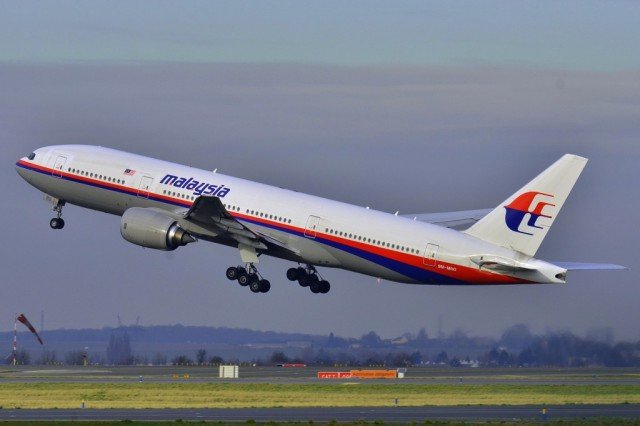
Malaysia Airlines’ losses widen after flight MH 370 vanished over two months ago
Of the 30% that trades on Malaysia’s stock exchange, most of that is owned by the country’s pension funds and other institutions, leaving a small proportion for retail investors to trade.
Overall though, Malaysia Airlines has lost more than 40% of its market value this year.
Flight MH370 went missing on March 8 while flying from Kuala Lumpur to Beijing, leading to a massive search and rescue operation that is still ongoing and may cost millions of dollars.
The Malaysian government believes the plane ended its journey in the Indian Ocean, but no trace of the plane or wreckage has been found so far.
The crisis led to a high number of cancellations and reputational damage to the carrier, including a 60% drop in sales from China.
About two-thirds of the 239 people on board MH370 were from China, prompting boycotts by some travel agents on the Mainland.
Malaysia Airlines chief executive Ahmad Jauhari Yahya said the disappearance of MH370 added to its poor results, which were “not unexpected”.
“The results were made worse with the impact on air travel in general following the disappearance of MH370. The whole market has reacted by slowing down demand,” he said in a statement.
The company “needs to accelerate efforts to improve its revenue stream and better manage our high costs which have increased” he added.
“This need has become even more urgent for Malaysia Airlines’ future survival and sustainability in a market that is not showing any signs of letting up on competition.”
Malaysia Airlines has been struggling in the face of high fuel prices, foreign exchange fluctuations and increased competition from budget carriers in the region.
“Further efforts need to be made to manage fuel costs which increased 14% despite a decrease in jet fuel price,” the company said.
Malaysia Airlines has racked up losses of more than $1.3 billion over the last three years and analysts expect that to rise further.
Malaysian Defense Minister Hishammuddin Hussein said at a news conference on Thursday that the government has no plans to financially bail out Malaysia Airlines.
Malaysia Airlines said much of the costs associated with the disappearance of MH370 will be covered by insurance.
However, the mounting red ink has increased speculation it may be forced to file for bankruptcy or possibly be broken up even though it is majority-owned by Malaysia’s state investment firm
Despite the grim outlook, Malaysia’s airline chief plans to continue with the company’s turnaround effort.
“We still have much work ahead of us to deal with the reality of the business and competition as a dynamic and nimble operation,” he said.
“MH370 has brought out the best of our Malaysia Airlines team to stand united to face the crisis. We will be leveraging on this team spirit to fight for our future.”
A full search of the suspected crash area of Malaysia airliner MH370 could take up to a year, officials said.
Speaking in Malaysia, Australia’s ACM Angus Houston said he was confident an “effective search” would find the plane.
Officials from Australia, China and Malaysia will meet in Canberra next week to discuss the ongoing search.
On Thursday a report revealed a four-hour gap between MH370’s disappearance and the start of a search operation.
The preliminary report, from Malaysia’s transport ministry, also revealed that air traffic controllers did not realize the plane was missing until 17 minutes after it disappeared off radar.
The plane, carrying 239 people, disappeared over the South China Sea as it flew from Kuala Lumpur to Beijing.
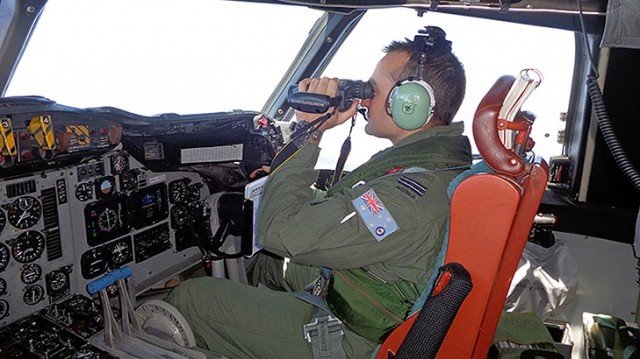
A full search of the suspected crash area of Malaysia airliner MH370 could take up to a year (photo Reuters)
Officials believe it ended its journey in seas west of the Australian city of Perth, thousands of kilometers off course, but do not yet know why. An intensive multinational search has so far turned up no sign of the plane.
Earlier this week, Australia announced that the operation was entering a new phase, after an initial search of the area where acoustic signals thought to be from “black box” flight recorders were heard found nothing.
Next week’s meeting in Australia will help determine what happens next.
“That’s a very important meeting because it will formalize the way ahead to ensure that this search continues with urgency and doesn’t stop at any stage,” said Angus Houston.
The aerial search for floating wreckage has been called off. The search of the sea floor will be expanded in the area where officials believe – based on satellite data – that the plane crashed.
“The search will take probably in the order of eight months, maybe eight to 12 months if we have bad weather or other issues,” Angus Huston said.
“But we’re totally committed to find MH370 and I’m confident that with an effective search we will eventually find the aircraft.”
Late on Thursday, Malaysian officials released their preliminary report on the missing airliner.
According to the draft, Vietnamese air traffic controllers contacted their counterparts in Kuala Lumpur at 01:38 to say MH370 was missing, 17 minutes after it disappeared off radar.
The official search-and-rescue operation was launched four hours later, at 05:30.
The report also recommended the introduction of real-time tracking of commercial air transport, saying there had now been two recent occasions when large planes had gone missing with their last position unclear – MH370 and Air France Flight 447 in 2009.
“This uncertainty resulted in significant difficulty in locating the aircraft in a timely manner,” the report noted.
There is no requirement from the International Civil Aviation Authority (ICAO), the UN body that oversees global aviation, for real-time tracking.
Malaysia Airlines, meanwhile, has asked relatives of passengers to leave the hotel accommodation it has been providing and go home.
The airline said it was “deeply sympathetic to the continuing unimaginable anguish, distress and hardship suffered by those with loved ones on board the flight”.
It warned that the continuing search would be a “prolonged process” and said relatives should wait for updates “within the comfort of their own homes”.
[youtube Ki3USbDKOXQ 650]
The Australian team co-ordinating the search for the missing Malaysian plane have played down marine survey company GeoResonance’s claim it has identified possible debris.
The Australia-based company said on Tuesday it might have located the wreckage of a plane.
But the agency leading the search said the area was not consistent with satellite data showing MH370’s likely flight path.
MH370 went missing on March 8 as it flew from Kuala Lumpur to Beijing.
Carrying 239 people, it disappeared off radar over the South China Sea. Based on satellite data, investigators believe it ended its journey in the sea far off the Australian city of Perth.
It is still not known why the plane went so far off course. Finding the “black box” flight recorders is seen as key to explaining what happened.
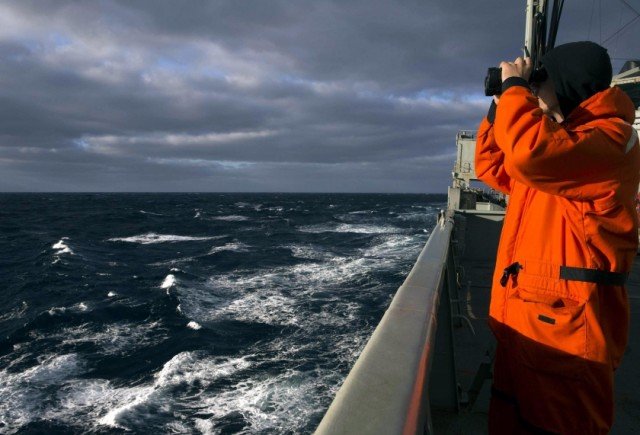
Australia-based marine survey company GeoResonance said on Tuesday it might have located the wreckage of a plane
Search efforts so far have focused on a “southern corridor” that the plane could have flown, based on calculations derived from “pings” the aircraft emitted after it disappeared off radar.
A robotic submersible has been scouring the sea floor in an area north-west of Perth after acoustic signals consistent with flight recorders were heard.
The possible wreckage identified by GeoResonance, however, was in the Bay of Bengal to the south of Bangladesh.
The company said it had used proven technology to search for a seafloor location where all the elements that comprise a Boeing 777 – such as titanium, copper, jet fuel residue – were present.
“The company is not declaring this is MH370, however it should be investigated,” it said.
It said it had passed the information on to relevant authorities in late March and early April.
In a statement, Australia’s Joint Agency Co-ordination Centre (JACC) said the Bay of Bengal location was not within the data-indicated search area.
“The joint international team is satisfied that the final resting place of the missing aircraft is in the southerly portion of the search arc,” it said.
Malaysian Defence Minister Hishammuddin Hussein said his country was “working with its international partners to assess the credibility of this information”.
Meanwhile, the search for Malaysia Airlines plane off Perth is continuing. The Bluefin-21, the robotic submersible, was due to embark on another underwater search mission when weather conditions eased, JACC said.
The air search for surface debris has ended, however. Australian PM Tony Abbott said on Monday that wreckage would most likely have sunk by now.
A “new phase” of the operation involving a more intensive underwater search was the planned strategy for the weeks ahead, Tony Abbott said.
[youtube i2b4RFpv0l4 650]
Australian officials have announced that the underwater search for the missing Malaysia Airlines plane could widen from its focused area in the Indian Ocean.
The Bluefin-21 submersible has completed 95% of its search in the area where possible signals from the plane’s flight recorder were heard on April 8.
If nothing is found, the Bluefin-21 will move to an adjacent area, the agency co-ordinating the search said.
Meanwhile, Malaysia said a report on the plane could be released next week.
Flight MH370 went missing on March 8 as it flew from Kuala Lumpur to Beijing with 239 people – mostly Chinese nationals – on board.
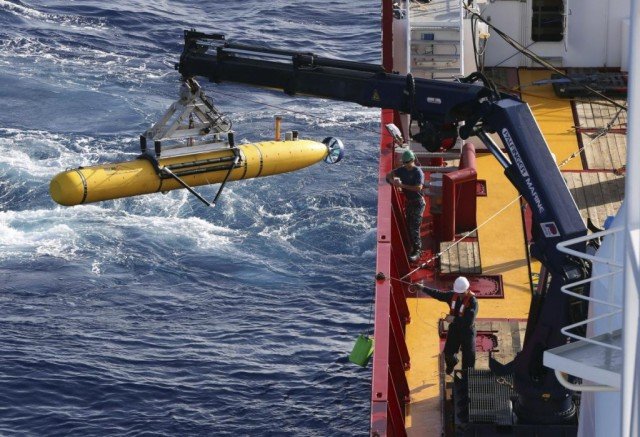
The underwater search for the missing Malaysia Airlines plane could widen from its focused area in the Indian Ocean
Using satellite data, officials have concluded that MH370 ended its journey in waters north-west of the Australian city of Perth.
However, the ongoing multi-national search for the missing plane has yet to yield anything concrete. The daily operation is already shaping up to be the most expensive in aviation history.
The robotic submarine Bluefin-21, operated by the US Navy off the Australian vessel Ocean Shield, is an autonomous underwater vehicle (AUV) that can identify objects by creating a sonar map of the sea floor.
It is operating at a depth of more than 13,000 feet.
The AUV has been mapping the area of the sea bed within a 10km (6.25 mile) radius of where acoustic signals believed to have come from the aircraft’s flight recorder were detected.
On Friday Australia’s Joint Agency Co-ordination Centre (JACC) said in a statement that the AUV had “completed approximately 95% of the focused underwater search area”.
“If no contacts of interest are made, Bluefin-21 will continue to examine the areas adjacent to the 10km radius,” JACC said.
“We are currently consulting very closely with our international partners on the best way to continue the search into the future,” JACC added.
Authorities still do not know why the plane went off course and finding the flight recorders is seen as key to understanding what happened.
Meanwhile, Malaysian PM Najib Razak told CNN on Thursday that there was “a likelihood” the report on the investigation into the missing plane could be released next week.
Malaysian officials said on Wednesday that the UN’s International Civil Aviation Organization already had a copy of the report.
In China, relatives of passengers on the missing flight held another protest outside the Malaysian Embassy in Beijing, after Malaysian officials failed to update them on the search.
[youtube E61sxP9wrTw 650]
Australian authorities are examining material washed ashore to determine if it is related to missing Malaysia Airlines flight MH370.
The debris was found by a member of the public near the town of Augusta, some 190 miles south of Perth.
Images of the debris have been sent to the Australian Transport Safety Bureau (ATSB), which is now investigating.
“It’s sufficiently interesting for us to take a look,” an ATSB chief Martin Dolan told CNN.
Martin Dolan said the debris looked like sheet metal with rivets in it, but added: “The more we look at it, the less excited we get.”
The ATSB confirmed it was examining the photographs “to determine whether further physical analysis is required and if there is any relevance to the search of missing flight MH370”.
The images have also been sent to authorities in Malaysia and the ATSB is expected to collect the material later on Wednesday.
The material was metallic and about 8ft long, ABC News reported.
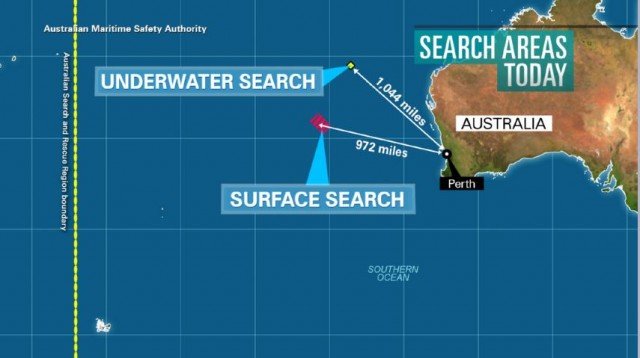
The debris was found by a member of the public near the town of Augusta, some 190 miles south of Perth
The Malaysia Airlines aircraft was carrying 239 people from Kuala Lumpur to Beijing when it disappeared in March.
Malaysia is running the investigation into the plane’s disappearance, but search efforts are being led by Australia’s Joint Agency Co-ordination Centre (JACC).
For the past two days, bad weather has prevented planes from taking part in the search about 990 miles north-west of Perth.
The US Navy Bluefin-21 mini-submarine scanning the ocean bed has covered more than 80% of a120 sq mile search area in the southern Indian Ocean, without finding any sign of debris in water.
Up to 10 military aircraft and 12 ships are currently taking part in the hunt. The daily operation, involving some two dozen nations, is already shaping up to be the most expensive in aviation history.
Australia said on Wednesday that it would not abandon the hunt, insisting that the cost of the operation was not a concern.
Australian PM Tony Abbott said if the current underwater search was unsuccessful, a new strategy would begin.
Defense Minister David Johnston has said that sophisticated sonar equipment will probably be used in the next stage.
“The next phase, I think, is that we step up with potentially a more powerful, more capable side-scan sonar to do deeper water,” David Johnston said.
Tony Abbott said the probable impact zone of the airliner was in an area of the sea floor 430 miles long and 50 miles wide.
In a separate development, Malaysian Transport Minister Hishammuddin Hussein said that his country’s cabinet had approved the formation of an international investigation team to find out what happened to the missing plane.
“The main purpose of the team is to evaluate, investigate and determine the actual cause of the accident so similar accidents could be avoided in the future,” he told reporters in Kuala Lumpur.
Australia says that it is now consulting with Malaysia, China and the US on the next phase of the search, which is likely to be announced next week.
Tony Abbott said a new search strategy would be put into action if nothing was found in the current seabed search.
“If at the end of that period we find nothing, we are not going to abandon the search, we may well rethink the search, but we will not rest until we have done everything we can to solve this mystery,” he said.
“We owe it to the families of the 239 people on board, we owe it to the hundreds of millions – indeed billions – of people who travel by air to try to get to the bottom of this.”
“The only way we can get to the bottom of this is to keep searching the probable impact zone until we find something or until we have searched it as thoroughly as human ingenuity allows at this time,” Tony Abbott said.
[youtube Gz_3DbqwHTk 650]
Malaysia’s acting Transport Minister Hishammuddin Hussein has announced that the search area for the missing MH370 plane has narrowed and will be at “a critical juncture” in the next two days.
Hishammuddin Hussein said underwater drone Bluefin-21 would finish searching the area within the next week.
The Bluefin 21 mini-submarine has so far found nothing after six missions.
Malaysia Airlines flight MH370 went missing on March 8 as it flew from Kuala Lumpur to Beijing carrying 239 people.
The Bluefin is mapping the area of the sea bed within 6 miles radius of where acoustic signals were detected believed to have come from the aircraft’s flight recorder.
It is operating at a depth of more than 13,000 feet.
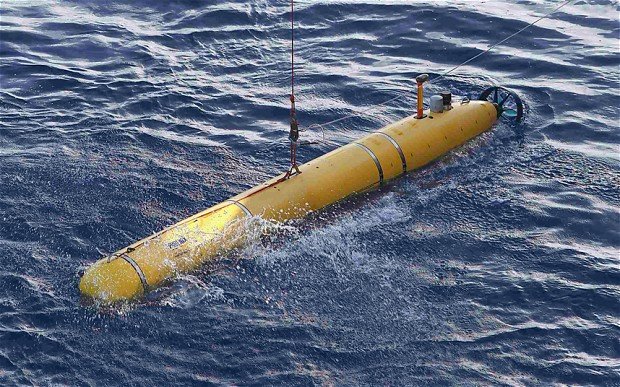
The Bluefin 21 mini-submarine searching for missing Malaysia Airlines plane has so far found nothing after six missions
Hishammuddin Hussein said it was important to focus on the search on Saturday and Sunday.
“The narrowing of the search for today and tomorrow is at a critical juncture,” he said.
“I appeal to everyone around the world to pray and pray hard that we find something to work on in the next couple of days.”
Using satellite data, officials have concluded that the MH370 ended its journey in seas west of the Australian city of Perth.
They do not know why the plane flew so far off course and finding the plane’s flight recorders is seen as key to understanding what happened.
The Bluefin-21, operated by the US Navy off the Australian vessel Ocean Shield, is an autonomous underwater vehicle (AUV) that can identify objects by creating a sonar map of the sea floor.
It is searching in an area defined by four acoustic signals picked up by an Australian search team, and was deployed after officials concluded that the batteries on the plane’s flight recorders would likely have expired, given their one-month shelf life.
Submersible Bluefin-21 has an operating depth of 4,500m (15,000ft) and on its first mission a built-in safety device returned it to the surface after it exceeded that depth.
The authorities have now adjusted the device to allow it to go as deep as 4,695m.
The Joint Agency Co-ordination Centre (JACC) said on Thursday that the machine could operate deeper than 4,500m at “a small but acceptable level of risk”.
[youtube X4tasymfcoE 650]
Mini-submarine Bluefin-21 searching for the missing Malaysia Airlines plane has completed a full mission at its third attempt.
Two previous missions to scour the floor of the Indian Ocean for wreckage were cut short by technical problems.
The data from the sub’s latest mission is being analyzed. Previous forays have not shown anything significant.
It is searching in the area acoustic signals thought to be from the missing plane’s “black box” flight recorders were heard.
Malaysia Airlines flight MH370 disappeared on March 8 as it flew from Kuala Lumpur to Beijing.
Using satellite data, officials have concluded that it ended its journey in seas west of the Australian city of Perth.
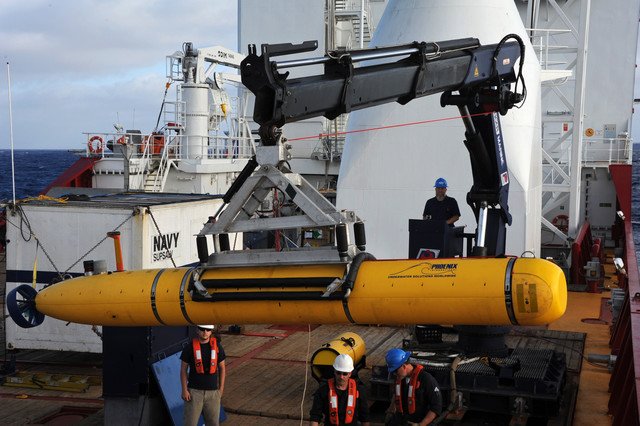
Bluefin-21 searching for the missing Malaysia Airlines plane has completed a full mission at its third attempt
They do not know why the plane flew so far off course and an investigation is ongoing. Finding the plane’s flight recorders are seen as key to understanding what happened.
The Bluefin-21, operated by the US Navy off the Australian vessel Ocean Shield, is an autonomous underwater vehicle (AUV) that can identify objects by creating a sonar map of the sea floor.
It is searching in an area defined by four acoustic signals picked up by an Australian search team, and was deployed after officials concluded that the batteries on the plane’s flight recorders would likely have expired, given their one-month shelf life.
The submersible has an operating depth of 15,000ft and on its first mission a built-in safety device returned it to the surface after it exceeded that depth.
Its second mission was also cut short because of unspecified technical difficulties, but the third mission – a full 16 hours, plus two hours each way for diving and surfacing – went according to plan.
“Overnight Bluefin-21 AUV completed a full mission in the search area and is currently planning for its next mission,” the Joint Agency Co-ordination Centre (JACC) said in a statement.
“Bluefin-21 has searched approximately 90 square kilometres to date and the data from its latest mission is being analyzed.”
JACC also said that an oil sample collected in the area the acoustic signals were heard had arrived in Perth for testing.
“We will provide details of the results when they become available,” it said.
Officials have warned that the search for wreckage on the sea floor could take weeks or months.
[youtube X9hAVbPz5OI 650]
Bluefin-21 robotic mini submarine deployed to search for the missing Malaysia Airlines plane in the southern Indian Ocean has had its first mission cut short.
The drone was sent to search the sea floor for wreckage after signals believed to be consistent with “black box” flight recorders were detected.
The Bluefin-21 exceeded its operating limit of 15,000ft and was brought back to the surface.
It was due to return later on Tuesday if weather conditions permitted.
“To account for inconsistencies with the sea floor, the search profile is being adjusted to extend the sonar search for as long as possible,” an update from the US Navy – which operates the Bluefin-21 – said.
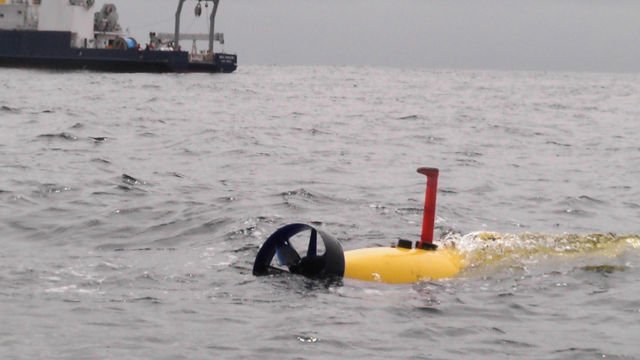
The Bluefin-21 exceeded its operating limit of 15,000ft and was brought back to the surface
The US Navy said in a later update that no objects of interest were found when the six hours of data were downloaded and analyzed.
Flight MH370 went missing on March 8 with 239 people on board. It was flying from Kuala Lumpur to Beijing when it lost contact with air traffic controllers over the South China Sea.
Malaysian officials believe, based on satellite data, that it ended its flight thousands of miles off course, in seas west of the Australian city of Perth.
Amid a major international search, an Australian navy vessel last week detected four acoustic signals using a US Navy towed pinger locator. Officials believe these could come from the missing plane’s flight recorders.
No signals have been detected since 8 April, however, leading to fears that the recorders’ batteries – which last about a month – have run out.
Bluefin-21 is an almost 5m-long vehicle that can create a sonar map of the sea floor. On Monday officials said each mission was expected to last 24 hours, with 16 hours spent on the ocean floor, four hours’ diving and resurfacing time, and four hours to download data.
The submersible has a safety feature that brings it to the surface if it exceeds its performance capabilities, however.
The sea where the Bluefin-21 is searching is estimated to be about 4,500m deep, but experts say there could be variations on the sea floor.
[youtube KfHvGVC8QMk 650]
Robotic submarine Bluefin-21 will be deployed for the first time to search for the missing Malaysia Airlines plane.
Air Chief Marshal Angus Houston said the Bluefin-21 drone would be sent down as soon as possible to search for wreckage on the sea floor.
Teams have been using a towed pinger locator to listen for signals from the plane’s “black box” flight recorders.
But no new signals have been heard since April 8, amid concerns the flight recorders’ batteries have expired.
Flight MH370 went missing on March 8 with 239 people on board. It was flying from Kuala Lumpur to Beijing when it lost contact with air traffic controllers over the South China Sea.
Malaysian officials believe, based on satellite data, that it ended its flight in the southern Indian Ocean, thousands of kilometres off course.

Teams searching for the missing Malaysia Airlines plane are to deploy robotic submarine Bluefin-21 for the first time
An international search has focused on waters west of the Australian city of Perth, with teams racing against time to detect signals before the flight recorder batteries – which last about one month – run out.
ACM Angus Houston, who heads the joint agency coordinating the search effort, said that given no signals had been detected in six days, it was time to go underwater.
The Bluefin-21 – an almost 5m-long underwater autonomous vehicle that can create a sonar map of the sea floor – will search for wreckage in an area defined by four signals heard last week.
Officials believe those signals – picked up by the pinger locator towed by an Australian vessel – are consistent with flight recorders.
“Analysis of the four signals has allowed the provisional definition of a reduced and manageable search area on the ocean floor,” ACM Angus Houston said.
“The experts have therefore determined that the Australian Defense Vessel Ocean Shield will cease searching with the towed pinger locator later today and deploy the… Bluefin-21 as soon as possible.”
Angus Houston warned that the submersible search would be a long, “painstaking” process that might, in the end, yield no results.
Each Bluefin-21 mission will last 24 hours, with 16 hours spent on the ocean floor, four hours’ diving and resurfacing time, and four hours to download data.
Australian vessel Ocean Shield had also spotted an oil slick in the same area where the signals had been heard, ACM Angus Houston said, and a sample was being sent for testing.
“I stress the source of the oil is yet to be determined but the oil slick is approximately 5,500m downwind… from the vicinity of the detections picked up by the towed pinger locator,” he said.
Australian officials have said previously that they are confident they are searching in the right area for the missing plane.
Officials have no idea yet why the plane diverted so far from its intended flight path. Investigators are looking at options including hijacking, mechanical failure, sabotage and pilot action.
[youtube z5hSb5YhnNI 650]
Malaysia Airlines flight MH370 co-pilot Fariq Abdul Hamid tried to make a call with his cellphone after the plane was diverted from its scheduled route, Malaysia’s New Straits Times reported investigative sources as saying on Saturday.
The newspaper cited unidentified sources as saying the attempted call from Fariq Abdul Hamid’s phone was picked up by a cellphone tower as the plane was about 200 nautical miles northwest of the west coast state of Penang. That was around where military radar made its last sighting of the missing jet at 2:15 a.m. local time on March 8.
“The telco’s [telecommunications company’s] tower established the call that he was trying to make. On why the call was cut off, it was likely because the aircraft was fast moving away from the tower and had not come under the coverage of the next one,” the New Straits Times cited a source as saying.

Malaysia Airlines flight MH370 co-pilot Fariq Abdul Hamid tried to make a call with his cellphone after the plane was diverted from its scheduled route
The publication quoted Malaysia’s acting Transport Minister Hishammuddin Hussein as saying that the report needed to be verified.
However, Hishammuddin Hussein appeared to cast doubt on the report by saying: “If this did happen, we would have known about it earlier.”
The New Straits Times cited separate investigative sources as saying that a signal had been picked up from Fariq Abdul Hamid’s cellphone, but that it could have resulted from the device being switched on rather than being used to make a call.
Malaysia is focusing its criminal investigation on the cabin crew and the pilots of the plane – 53-year-old captain Zaharie Ahmad Shah and 27-year old co-pilot Fariq Abdul Hamid – after clearing all 227 passengers of any involvement, police have said.
Investigators believe that someone with detailed knowledge of both the Boeing 777-200ER and commercial aviation navigation switched off the plane’s communications systems before diverting it thousands of miles off its scheduled course.
[youtube Qdx5z-_I_G4 650]
Australia’s PM Tony Abbott said signals in remote seas thought to be from the missing Malaysia Airlines flight MH370 are “rapidly fading” and finding the jet will be a “massive, massive task”.
Tony Abbott said he was confident “pings” detected by search teams were from the aircraft’s black boxes.
But no new signals have been confirmed in the search area since Tuesday.
“No one should underestimate the difficulties of the task still ahead of us,” Tony Abbott warned.
Correspondents say Tony Abbott appeared to be couching his comments from Friday, in which he said he was “very confident” that signals heard by an Australian search ship were from the missing Boeing 777.
Speaking during a visit to China, Tony Abbott said teams were hoping to track further signals in a section of the southern Indian Ocean before shifting the search operation to the seabed.

Australian PM Tony Abbott said he was confident pings detected by search teams were from the missing Malaysia Airlines plane’s black boxes
“Trying to locate anything 4,500 metres [15,000 feet] beneath the surface of the ocean, about a 1,000km [620 miles] from land is a massive, massive task,” Tony Abbott said.
“Given that the signal from the black box is rapidly fading, what we are now doing is trying to get as many detections as we can so that we can narrow the search area down to as small an area as possible.”
Tony Abbott said a submersible drone would be sent to conduct a sonar search of the seabed once search teams were confident with the area identified – but he refused to say when that might be.
After analyzing satellite data, officials believe Malaysia Airlines plane with 239 people aboard flew off course for an unknown reason and went down in the southern Indian Ocean off the west coast of Australia.
Those leading the search fear that time is running out because the batteries that power the pings from the black box only last about a month, and that window has already passed.
Two sounds heard a week ago by the Australian ship Ocean Shield, towing the ping locator, were determined to be consistent with the signals emitted from the black boxes. Two more pings were detected in the same general area on Tuesday.
On Thursday, an Australian aircraft picked up an audio signal in the same area as the four previous detections but officials now believe it is unlikely to be related to the black boxes
The underwater search zone is currently a 500 miles patch of the seabed, about the size of Los Angeles.
The submersible drone, Bluefin 21, takes six times longer to cover the same area as the ping locator and it would take about six weeks to two months for it to search the current zone.
Complicating matters is the depth of the seabed in that area. The signals are emanating from 15,000 ft below the surface, which is the deepest the Bluefin can dive. The search coordination centre said it was considering options in case a deeper-diving sub was needed.
[youtube uqLs-RDS7xo 650]
An Australian P-3 Orion aircraft searching for missing Malaysia Airlines flight MH370 has detected a possible new signal in the southern Indian Ocean, Australian officials say.
The plane picked up the signal in the same area where an Australian vessel detected audio pings earlier this week, officials said.
The signal would require further analysis, but could have been from a “man-made source”, officials said.
Flight MH370 vanished on March 8, with 239 people on board.
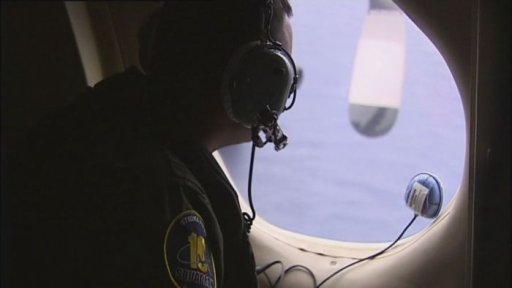
The Australian plane picked up the signal in the same area where a vessel detected audio pings earlier this week
The search zone was tightened on Thursday after a US navy “towed pinger locator” picked up audio signals in the area, sparking hopes that the plane’s black box was in the area.
Australian vessel Ocean Shield picked up four acoustic signals in the area, twice over the weekend and twice on Tuesday.
Speaking after the latest possible signal was detected, retired Air Chief Marshal Angus Houston, who is leading search efforts, said: “The acoustic data will require further analysis overnight but shows potential of being from a man-made source.”
Up to 14 planes and 13 ships are involved in Thursday’s search, scouring an area of 22 300 sq miles, around 1,400 miles north-west of Perth. It is the smallest designated area in the hunt to date.
Planes have dropped buoys equipped with hydrophone listening devices into the water to help pick up signals.
The batteries on the black box only last about a month, so teams need to work quickly to track the audio signals before they stop broadcasting.
Malaysia has come under criticism for its handling of the search, with families of the passengers on the plane accusing the authorities of a lack of transparency.
The investigation came under further scrutiny after it emerged that the final words from the plane were “good night Malaysian three seven zero”, and not “all right, good night”, as previously reported by the government.
Australian vessel Ocean Shield searching for the missing Malaysia Airlines plane has reacquired signals that could be consistent with “black box” flight recorders.
The Ocean Shield heard the signals again on Tuesday afternoon and evening, the search chief said.
Signals heard earlier had also been further analyzed by experts who concluded they were from “specific electronic equipment”, Angus Houston said.
Flight MH370 disappeared on March 8, carrying 239 people.
It was travelling from Kuala Lumpur to Beijing when it lost contact with air traffic controllers.
Malaysian officials say that based on satellite data, they believe it ended its flight in the southern Indian Ocean, thousands of miles from its intended flight path.
“I believe we are searching in the right area,” said Air Chief Marshal Angus Houston, who heads the joint agency co-ordinating the search.
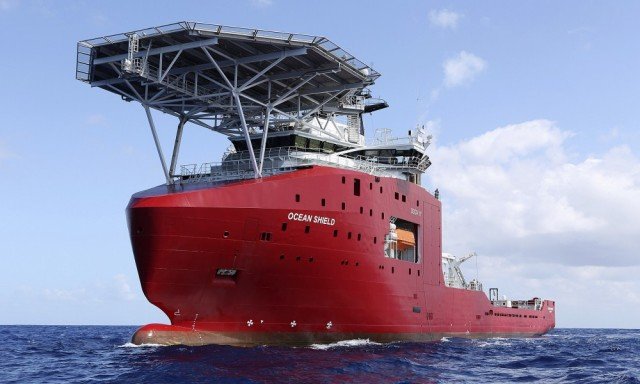
Australian vessel Ocean Shield searching for the missing Malaysia Airlines plane has reacquired signals that could be consistent with “black box” flight recorders
“But we need to visually identify aircraft wreckage before we can confirm with certainty that this is the final resting place of MH370.”
The Ocean Shield has been towing a US Navy pinger locator to listen for signals from the plane’s flight recorders in waters west of the Australian city of Perth.
It twice acquired signals over the weekend.
On Tuesday, it located the signals again, the first time for five minutes and 32 seconds, and the second time for around seven minutes, said ACM Angus Houston.
“Ocean Shield has now detected four transmissions in the same broad area,” he said.
“Yesterday’s signals will assist in better defining a reduced and much more manageable search area on the ocean floor.”
The signals have been heard in sea with a depth of 15,000 feet.
ACM Angus Houston said it was important to refine the search area as much as possible before sending down the Bluefin 21 underwater drone to search for wreckage.
“Now hopefully with lots of transmissions we’ll have a tight, small area and hopefully in a matter of days we will be able to find something on the bottom,” he said.
Experts at the Australian Joint Acoustic Analysis Centre had also analyzed the first two signals heard over the weekend, he added.
Their analysis showed that a “stable, distinct and clear signal” was detected. Experts had therefore assessed that it was not of natural origin and was likely from specific electronic equipment.
“They believe the signals to be consistent with the specification and description of a flight data recorder,” ACM Angus Houston said.
Search teams have been racing against time to locate signals from the flight recorders before their batteries expire after about one month.
Investigators still do not know why MH370 strayed so far off course, after disappearing over the South China Sea between Malaysia and Vietnam.
[youtube MnRXtPisBpw 650]
According to experts, the Chinese ship that detected a sound in the southern Indian Ocean consistent with a black box “ping” while searching for missing Malaysia Airlines plane may have simply been listening to itself.
That possibility illustrates just how complicated the task is to locate the transmitters from the lost MH370 flight.
Australian Air Chief Marshal Angus Houston warned Tuesday – 32 days since Flight 370 vanished after takeoff from Kuala Lumpur – that other ships are being kept away from the search area to prevent any further confusion about signal noise.
“We can’t have too many ships in the area, because when you are dealing with these transmissions, you need utter silence,” he said.
“It becomes a very noisy environment if you suddenly have several ships around there or ships dropping things in the water.”

Chinese ship Haixun 01 detected a sound in the southern Indian Ocean consistent with a black box ping while searching for missing Malaysia Airlines plane
The crew of Chinese ship Haixun 01 announced Saturday they had recorded fleeting pings off Australia’s west coast, but their discovery occurred more than 350 miles from where the Australians say sustained and repeated pings were found Sunday.
Video of the Chinese ship appeared to show an extra pinger on board. That pinger would just need to get wet for it to start transmitting – noise that could then get picked up by the ship’s search crews, said Anish Patel, president of pinger maker Dukane Seacom. The company supplies black-box beacons for Malaysia Airlines.
“It takes the slightest bit of moisture for that water-activated switch to automatically fire up,” Anish Patel said.
He added that it’s “not best practice” during a search to keep another pinging device where you’re listening.
Video on China’s CCTV shows the crew of the Haixun 01 boarding a small dinghy and using a handheld hydrophone, which was lowered into the water on a pole, to listen for the pings from the missing jet’s two black boxes.
Experts have said that while it’s possible that such a device could pick up pings from the ocean, it’s highly unlikely in this case. The maker of the hydrophone technology used by the Chinese said it’s intended for shallower waters and requires the user to be much closer to the transmitter. The depth of the ocean in the search area is as much as 3 miles.
The Chinese said they recorded the fleeting pings on Friday and Saturday off Australia’s west coast. The signal’s frequency was recorded at 37.5 kHz per second – the same that would be emitted by flight recorders and a noise that does not occur naturally in the ocean.
Australia also is dragging a ping locator in the search area, and officials said signals it picked up late Saturday and early Sunday were stronger and lasted longer than the ones detected by the Chinese.
Those noises haven’t been heard since. The signals would become fainter over time as the beacons’ battery life slowly dies out. That typically takes about a month.
Malaysia Airlines Flight MH370 disappeared en route from Kuala Lumpur to Beijing one month ago.
For 30 days, search and rescue teams have patrolled areas of the southern Indian ocean, thousands of miles apart.
Planes, ships and submarines have all been deployed.
China, Australia, Malaysia, the US, the UK New Zealand, Japan and South Korea have all contributed to the search.
The question is: How much is it costing, and who pays?
Malaysia has refused to be drawn. Acting Transport Minister Hishamuddin Hussein told reporters that the cost of mounting the search was “immaterial” when set against the need to bring solace to the families of the missing.
Mounting a search operation on this scale, and for this length of time, does not come cheap.
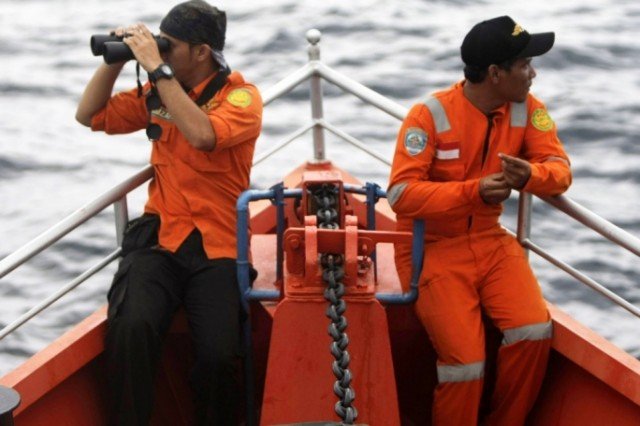
For 30 days, search and rescue teams have patrolled areas of the southern Indian ocean, thousands of miles apart
The bill so far probably runs to $33-42 million, estimates Peter Roberts, senior research fellow in sea power and maritime studies at the Royal United Services Institute (RUSI).
This includes the cost of fuel, spare parts, and transporting supplies, as well as the relocation of staff – even costs such as cancelled leave can push up the final bill.
Most of the financial burden will be borne by the countries who have contributed their forces.
For example, Australia deployed a navy replenishment vessel, HMAS Success, two weeks ago. It costs AU$550,000 a day to operate, says the Department of Defense, so that comes to AU$7.7 million ($7.2 million) already.
And that is just a single ship. HMAS Toowoomba, which has also been involved, costs AU$380,000.
The US Department of Defense set aside $4 million to help the search: between March 8 and 24, it spent $3.2 million, a spokesman told reporters in Washington.
In the end, the cost of sending HMS Echo to the waters off Australia will be met from Treasury contingency funds, says Peter Roberts. Governments will take the costs within their budget “and accept they have to do it”.
The ship will stay there as long as it has a role to play, he says: “Mariners have got a very strong sense of brotherhood: saving life at sea is the right thing to do.”
Once the search is completed, attention is likely to turn to improving the tracking technology.
“It is hard for anyone to imagine that we can’t continuously track aircraft anywhere in the world,” says Peter Roberts.
There, the most expensive part of the process will not be the development or fitting of any technology, but the cost of getting it accepted and standardized by aviation regulators around the world.
The most expensive salvage operation in aviation history came after an Air France flight from Rio de Janeiro to Paris crashed in the Atlantic in 2009.
After multiple searches over three years, the final bill came to 32 million euros ($44 million).
[youtube vh-2k41mrQw 650]
Teams searching for the missing Malaysia Airlines plane will wait for further contact with signals picked up over the weekend before using a submersible down to search for debris.
Australian Ocean Shield vessel has heard signals that officials said could be consistent with “black box” flight recorders.
It has not been able to reacquire them since Sunday, however.
Australian officials said it was key to re-find the signals before using a submersible in a search for wreckage.
Flight MH370 went missing on March 8 with 239 people on board. The Beijing-bound plane lost contact with air traffic controllers shortly after taking off from Kuala Lumpur.
Malaysian officials say that – based on satellite data – they believe the plane crashed into the southern Indian Ocean, west of the Australian city of Perth, thousands of miles from its intended flight path.
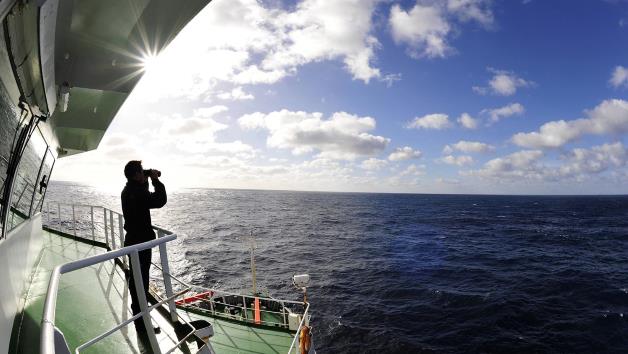
Teams searching for the missing Malaysia Airlines plane will wait for further contact with signals picked up over the weekend before using a submersible down to search for debris
In Beijing, relatives of missing passengers held a vigil to mark one month since the plane disappeared.
Speaking at Pearce Airbase in Perth, Australian Defense Minister David Johnston said that several days of “intense action” were ahead as search teams tackled “this difficult, complex task” while black box pingers were still believed to be active.
Australian vessel Ocean Shield has been using a towed pinger locator to listen for transmissions from the plane’s flight recorders. Over the weekend, it heard signals on two separate occasions, the first time for more than two hours.
On the second occasion two distinct pinger returns were audible, something said to be consistent with transmissions from both the flight data recorder and the cockpit voice recorder.
Air Chief Marshall Angus Houston, who heads the agency overseeing the search for the plane, said that Ocean Shield had had no further contact with any transmissions since then.
He said that work involving the towed pinger locator would continue for several days, adding that the Bluefin 21 underwater drone would not be deployed unless more transmissions were received.
“If we can get more transmissions we can get a better fix on the ocean floor, which will enable a much more narrowly focused visual search for wreckage,” he said.
[youtube 2elvgBNm6MA 650]
Australian defense vessel Ocean Shield searching for the missing Malaysia Airlines plane has detected signals consistent with those from black box flight recorders.
The Ocean Shield acquired the signal twice, once for more than two hours, said Air Chief Marshal Angus Houston, who is leading the search.
He called it the “most promising lead” so far.
However, ACM Angus Houston said more information was needed: “We haven’t found the aircraft yet and we need further confirmation.”
Malaysia Airlines plane, carrying 239 people, was flying from Kuala Lumpur to Beijing on March 8 when it disappeared. Malaysian officials say they believe it crashed in the southern Indian Ocean.
ACM Angus Houston said the signals were detected using the towed pinger locator deployed on the Ocean Shield.
Two separate detections occurred, he said. The first was held for two hours and 20 minutes before being lost.
The ship then turned around and on the return leg detected the signal again for 13 minutes.
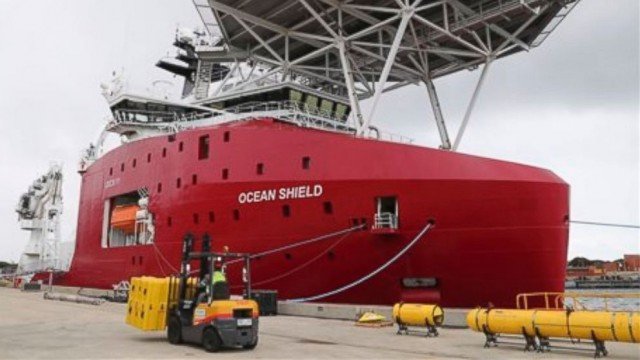
Australian defense vessel Ocean Shield searching for the missing Malaysia Airlines plane has detected signals consistent with those from black box flight recorders (photo AP)
“On this occasion two distinct pinger returns were audible. Significantly this would be consistent with transmissions from both the flight data recorder and the cockpit voice recorder,” ACM Angus Houston said
“We are now in a very well defined search area, which hopefully will eventually yield the information that we need to say that [Malaysia Airlines flight] MH370 might have entered the water just here.”
The Ocean Shield was still in the area but had not been able to reacquire the signals since, he said.
The position of the signals needed to be fixed, ACM Angus Houston said. Once that happened, the Ocean Shield could lower the Bluefin 21 underwater autonomous vehicle to try to locate wreckage on the sea floor.
The signal had been heard in sea with a depth of 4,500m, he added, which was at the limit of the capability of the Bluefin 21.
ACM Angus Houston cautioned that the next steps would take time.
“It could take some days before the information is available to establish whether these detections can be confirmed as being from MH370,” he said.
“In very deep oceanic water, nothing happens fast.”
The search operation is in a race against time as the flight recorders’ batteries are due to run out, meaning a signal would no longer be emitted.
A Chinese search vessel, Haixun 01, also said it briefly heard signals over the weekend in a different search area.
Those signals are now being investigated with the help of a British naval vessel, HMS Echo, which is equipped with sophisticated sound-locating equipment.
Reports said the crew of the Chinese ship had been using a sonar device called a hydrophone to pick up sounds.
Experts said it was technically possible but unlikely that the sounds heard with this equipment related to the missing plane.
Chris Portale, a director of the US company Dukane which makes the device that emits signals from flight recorders, said looking for the Malaysian plane’s “black boxes” was like “looking for a suitcase on the side of a mountain” but under water.
So far, not a single piece of wreckage has been found from the missing plane, but officials have concluded – based on satellite data – that it ended its flight in the sea to the west of the Australian city of Perth.
[youtube IABvkcL3Yx4 650]
Australia’s Air Chief Marshal Angus Houston coordinating the search for missing Malaysian Airlines plane say a Chinese ship has detected a pulse signal for a second time, within hours of it being heard earlier on Saturday.
ACM Angus Houston called the discovery in the southern Indian Ocean an “important and encouraging lead”.
He warned that the data were still unverified.
British naval ship HMS Echo is sailing to the area to investigate further.
It is expected to arrive in the early hours of Monday.
Australian aircraft were also on their way, ACM Angus Houston told reporters. Australian naval vessel Ocean Shield would be heading to the latest search area once it had investigated a third acoustic detection elsewhere.
Both HMS Echo and ADV Ocean Shield have technology able to detect underwater signals emitted by data recorders.

A second pulse signal was detected less than 1.2 miles from the original
Malaysia Airlines flight MH370 disappeared on March 8 with 239 people on board. Investigators believe it crashed in the Indian Ocean although no confirmed debris has been found. The battery-powered signal from the “black box” recorders fades after 30 days.
After confirming details of the first pulse detected on Saturday which had “characteristics consistent with” an aircraft’s flight recorder, Angus Houston told a news briefing at Pearce Air Base near Perth of a second signal.
“[Saturday] afternoon Perth time, there was another acoustic detection less than 2 km [1.2 miles] from the original.”
The second signal lasted about 90 seconds, he said.
The search coordinator insisted the latest developments should be treated as unverified “until such time as we can provide an unequivocal determination”.
“We are working in a very big ocean and within a very large search area, and so far since the aircraft went missing we have had very few leads which allow us to narrow the search area,” he said.
“I assure you that we will follow up and exhaust every credible lead that we receive.”
A dozen military aircraft and 13 ships are already searching three areas about 1,240 miles north-west of the Australian city of Perth.
Australian PM Tony Abbott earlier said he was “hopeful but by no means certain” that the signal detected on Saturday was linked to missing flight MH370.
Haixun 01 picked up the first so-called “ping” signal at about 25 degrees south latitude and 101 degrees east longitude, state-run Xinhua news agency said.
The signal reportedly had a frequency of 37.5 kHz – the same as that emitted by the flight recorders.
Three people on board the boat were said to have heard the pings, which were not recorded as they came suddenly.
Xinhua also reported that a Chinese military plane had spotted a number of white floating objects about 60 miles away a few hours earlier.
[youtube 3EOQPNuCUjE 650]
[youtube 4PU0m0f8r2w 650]
One of the Chinese ships searching for the missing Malaysia Airlines plane in the southern Indian Ocean has picked up a pulse signal, Chinese media say.
They say the signal has a frequency of 37.5kHz – the same as those emitted by the flight recorders.
However, there is no evidence so far that it is linked to the missing flight MH370.
Dozens of ships and planes have joined the search, with the operation moving into its most intensive phase before batteries on the data recorders fade.
On Saturday the Haixun 01 – one of two Chinese ships in the area – picked up the signal at about 25 degrees south latitude and 101 degrees east longitude, the state-run Xinhua news agency said.
“It is yet to be established whether it is related to the missing jet,” it cautioned.
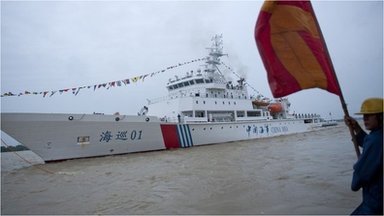
Dozens of ships and planes have joined the search for MH370, with the operation moving into its most intensive phase before batteries on the data recorders fade
China’s Liberation Daily reported that three people on board had heard the signals, which were not recorded as they came suddenly.
The head of the Australian agency co-ordinating the search said the reported signals “are consistent with the aircraft black box” but “there is no confirmation at this stage that the signals and the objects are related to the missing aircraft”.
The flight is believed to have crashed in the southern Indian Ocean, although no confirmed debris has been found.
It is still not known why the plane diverted from its planned flight path from Kuala Lumpur to Beijing four weeks ago with 239 people on board.
Two of the ships searching an area of about 84,000 sq miles have underwater locator capabilities.
Australian naval vessel Ocean Shield is using a “towed pinger locator” from the US Navy, while HMS Echo, which has similar capabilities, is also searching.
They are trying to detect an underwater signal emitted by the data recorders.
The battery-powered signal fades after 30 days.
The area – about 1,000 miles north-west of Perth – has been picked on the basis of analysis of the satellite data.
On Saturday, Malaysia announced it had set up three ministerial committees to help co-ordinate the search, and a new investigation team which would include members from Australia, China, the US, the UK and France.
[youtube p5nw6X2-Jfs 650]
123...4Next  Page 1 of 4
Page 1 of 4

























